The Geektionary N-S
Note: You will notice that The Geektionary occasionally uses first person references in violation of this site's standards and practices. This is the exception that tests the rule. Don't anyone else do this.
More Pages:
N
Nigouki
See -gouki.
Nissan
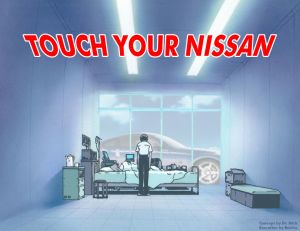
You know the world is about to end when even the great Hideaki Anno has sold his soul to appear in a car commercial. What's even richer than that is this particular advertising campaign's slogan: “Touch your Nissan”. Hmmm… Sounds like another “euphemism”, if you know what I mean… :wink wink nudge nudge:
n00b
There are “newbies” — and then there are n00bs. We all started as one or another. There are some "subtle" differences between the two: Newbies might be green, but they possess, for one thing, the ability to type legibly, with (at least 90% of the time) proper spelling, grammar, and punctuation. (This is a 1337 5|<i11 that many people never acquire, unfortunately.) They tread the waters of new territory carefully and respect the veterans. They are also willing to admit to their ignorance (something even the “experts” should do, BTW), but they are nonetheless eager to learn. N00bs, on the other hand, are characterized primarily by their lack of 1337ness and teh 5|<i11z. They possess one or more of the following traits: Their text is generally incomprehensible. They are unfamiliar with the concept of Google or forum search tools, so they regularly ask things that have been asked 42,000 times before (“What's the difference between normal and Platinum?”, “Which movie do I watch first?”, etc.), even though finding the answer is ludicrously easy. They create really stupid topics, act like morons, and/or make lots of posts that contribute nothing (= spam). Their netiquette and knowledge of the rules is often lacking. They suffer from a surfeit of impudence. Those who possess all or most of the above achieve the status of st00pid n00b.
Granted, there are many shades in between the two extremes. Some newbies can be jerks, and some n00bs can be okay. The greatest n00bs manage to advance beyond their larval forms, pupate, and emerge as beautiful butterflies with the NGE know-how, finally capable of inducting the latest wave of greenhorns — but this tends to happen more often with newbies.
NPC

New Production Cut. While looking through my Groundwork of Evangelion books, I stumbled across the term shinsaku KATTO 新作カット (literally, “new production cut”) used in reference to the material added to the Video & LD versions of episodes #21 ~ #24. While the updated versions of these episodes are officially referred to as the “Video & LD” versions, this terminology is very confusing to poor Westerners who have been acquainted with NGE by way of ADV: Rather than having their releases correspond directly to those of the Japanese, ADV instead gave us the televised versions of episodes #21 and up with their initial video cassette and DVD releases of Evangelion. (This is because the Japanese video releases were delayed as a result of these episodes being reworked, and ADV wasn't of the mind to wait.) When ADV finally did release the Video & LD versions of those four episodes domestically, they were christened the “Directors' Cut” episodes — although this terminology is also confusing, since it leads some to believe that material was CUT from the original release, whereas, in actuality, all of the added and modified material was produced specifically FOR the video release. “New Production Cut” is thus more useful among Westerners than “Video & LD Version” and less ambiguous than “Directors' Cut” — so I zealously promoted the usage of the term.
As it would go, though, later findings led me to believe that shinsaku KATTO referred NOT to episodes #21′ through #24′ in their entirety, but only to the cuts produced anew for them. Ergo, any additional or modified cut (not in the original OA version) would be a “newly-produced cut”. The term apparently also refers to the cuts produced exclusively for DEATH. However, since my efforts have already acid-etched “NPC” into the brains of my cohorts, it has become a bit too late to revoke the acronym on account of what is essentially a technicality. It remains useful, so it might as well be used.
Nucleola
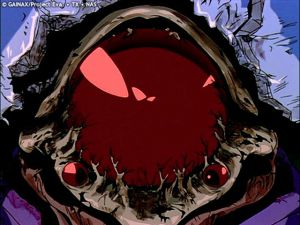
(Pl.: nucleolae) EVA-01 possesses two (later, four) of what look like miniature cores around the big one, but what exactly these things are is never elaborated upon.
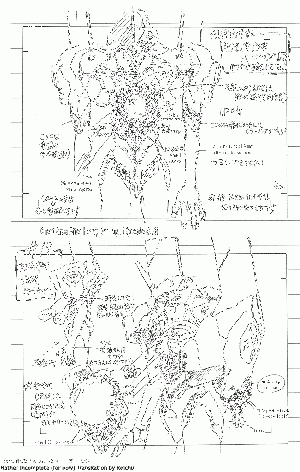
Production drawings refer to these only as chiisana na koukyuu, or "small light-spheres/cores" (koukyuu is used interchangeably with KOA , "core"). Since "small light-spheres/cores" is rather ungainly, I fabricated the term "nucleola" (the feminine diminuative form of Latin nucleus, "kernel" or "core") as a general-purpose substitute.
O-P
OP
Opening. I.e., the opening sequence of an anime, or whatever. Like ED, this is genuine anime industry shorthand.
Pierre
See Seele Dudes.
Platinum
The domestic release of Renewal, minus the movies (Death and EoE) owing to the fact that Manga is sitting on the license (and apparently lacks the sense to obtain and localize the remastered movies). The presentation is minimally altered from the original Japanese release, down to including translated versions of the booklets included with the individually-released Renewal volumes (although the actual content has been distributed in a different manner). Titles are soft rather than permanently imposed onto the picture. And, yippity skippity!, the subtitle translation has been finely tweaked, 95% of the time for the better, rendering these scripts the best ones currently available for the TV series. There are some complaints, such as the absence of any of the Renewal DVD Box-Set's extras save for the animatics included on the bonus disc, along with the suckage of all other included extras. Additionally, the image is not as crisp as Renewal's (but, bizarrely, Platinum gives us MORE of the picture), the DVD menus do not undergo the same progressive change from first disc to last (i.e., they retain the same look throughout), the scrolling notes from the DVDs were not translated for inclusion, and so on. I guess we can live, though…
Platinum Special Features
With ADV's domestic release of the remastered TV series, they attempted to out-do AWL's prior efforts (e.g., the Commentary of Evil) with their own substandard “bonus” features. This included, of course, commentary on select episodes featuring Matt Greenfield (Emperor of ADV) and the various dub actors who worked on NGE. The initial commentaries were mostly useless — focusing on localization, dubbing, and western fandom — although this could be considered a blessing in disguise, since, by not touching the meat of NGE, they didn't get to follow AWL's footstops and prove how utterly little they actually knew about the show. Too bad it didn't last. Soon enough, Greenfield dug up an NGE fan who he felt would add some actual insight on the show to the special features.
And, thus, the name of Sean McCoy began its descent into infamy. None of us had even heard of the guy. Seems he used to prowl Usenet in the late 90's, spreading some rather … interesting theories, notably the one about how Shinji and Asuka had sex in EoE, and Asuka's final words (“Kimochi warui”) were in direct reference to morning sickness. What ended up on the DVDs wasn't any better. The commentary tracks featuring him are bad enough, but the real offender is the dazzling two-part special feature entitled The Mythology of Eva, wherein Greenfield and McCoy join forces to conjure BS far more potent and awe-inspiring than either could achieve alone. Eva Monkey put it best: “It is essentially an hour of two guys talking about something they really don't know very much about, making all sorts of unfounded religious, psychological, and sexual insinuations, and taking plenty of time out of their intellectual ramblings to insist that the correct technical term for the Interface Headset is ‘Hoo-Hoos’. … Simply watching The Mythology of Evangelion is enough to make me want to down a bottle of aspirin, slit my wrists, and jump off a bridge. It's that bad.” Shin-seiki colorfully added, “(Greenfield and McCoy) leave a distinct impression of having been under the influence of mind-altering substances at the time they watched NGE and formed their opinions regarding what it was all about.”
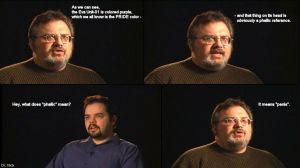
For those who can't be bothered to suffer through it, this image (courtesy of Dr. Nick and ReDeath) gives you the basic idea.
Pre-3I Instrumentality (P3II)
This is a term coined by Shin-seiki to refer to the weird sequence in #26′ that involves a mind meld between Shinji, Asuka, Misato, Rei, and Ritsuko — beginning with the "sandbox" scene and ending with Shinji choking Asuka in the kitchen — just before the consequent Third Impact and 'full-fledged' Instrumentality occur. There are those who claim that it was 'all in Shinji's head', although this idea is easy to rip apart due to its many holes.
Q-R
Quantum Magic
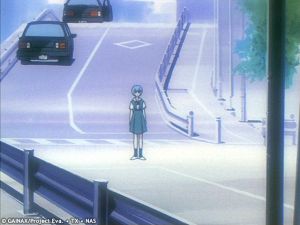
A term coined by Reichu as a short-hand reference to an idea I proposed as a possible explanation of certain phenomena in NGE (for the most part associated with Rei) which seem to violate the ordinary constraints of time and space. Notable examples include the apparent simultaneous existence of Rei's soul in Rei 2 and Zerogouki, and the temporal paradox of the Rei apparitions that appear before Misato and Ritsuko in #25′, even though Rei doesn't return to Lilith until #26′. There are various references to sub-atomic physics and quantum mechanics throughout the series: for example, the Dirac Sea; the references to quarks, etc., among the graffiti in Rei's birthplace in Terminal Dogma,
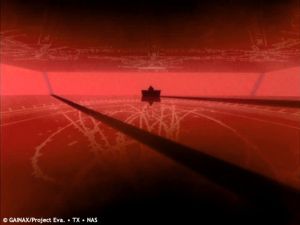
and the image on the floor in Gendo's office, which appears to depict the tracks of high-energy atomic collisions in a cyclotron. In light of these, it has occurred to me that if one posits the notion that souls in NGE function in a manner analogous to some of the counter-intuitive parameters of behavior of sub-atomic particles — e.g., that a single electron may, in certain circumstances, be said to exist in two places at once — that quantum mechanics famously entails, some sense could be made of these soul-related paradoxes. ~Shin-seiki
RCB
Red Cross Book. This is the typical gaijin way of referring to the untitled End of Evangelion theatrical program book. However, those of us who want to be cool and hip (or possibly just pedantic) go to the trouble of actually writing out "End of Evangelion <insert description of choice>".
Redmond, Dennis
If you think Matt Greenfield and Sean McCoy made art out of overinterpreting Evangelion, you ain't seen nothing yet. With his book The World Is Watching: Video as Multinational Aesthetics, 1968-1995, Dr. Dennis Redmond — the University of Oregon's gift to the academic world — immortalized his place in the grand pantheon of Eva-induced fucked-upness in a way that has made even the toughest of veteran geeks gasp in amused disbelief. Stylistically resembling “Commentary Project Light”, Redmond's approach is, however, not completely without a merit. In fact, despite his sometimes laughable juxtapositions and out-of-the-blue topic switches, about 75 percent of his writings are almost readable analysis. But, not unlike the show he's babbling about, in the end things go batshit crazy. Logic and common sense take a leap out of the window as Redmond starts interpreting the dramatic events of episode #24 from the viewpoint of global economic situation in the 1990's and — well, here's a short quotation. See for yourself:
"He chooses the future, and monopoly- national temporality falls into global space. Kaoru [sic] relinquishes his strangehold over the machinery of the Eurostate, at the same time that Asiazilla sheds the mask of an unbridled East Asian industrialism."
For understandable reasons, only the few bravest members of the commentary crew have put their sanity in jeopardy by reading the relevant chapters of Redmond's book in their entirety. For those dudes bad enough to take up the challenge, here's where the monstrosity lurks. This 200 pages long brain fart is also available in printed form, if you feel like spending fifty bucks on a book that you can read, 100% legally, for free on the Internet. —Dr. Nick
REGK
See EGK.
Reiquarium
The LCL-filled tank inside the Dummy Plug Plant containing Gendo's backup stock of Rei clone bodies, the number of whom changes depending on which version of the scene you happen to be viewing. And, to make a portmanteau out of a portmanteau: The Shinjiquarium is a bizarre variation upon one of the Reiquarium shots (the clones lifting up their heads in unison) occuring in EoE, wherein the Rei faces morph into Shinji faces -- but their bodies remain the same! (We already knew that Shinji Likes Boobies™, but this is ridiculous...!!)
Rei-tachi

The proper plural form of “Rei”. Brief grammar lesson: For names and terms of Japanese origin, adding “s” to the end to pluralize is an abomination! There are no such things as samurais, geishas, kimonos, etc. By default, the concept of number in Japanese is either unstated or indicated through other means (such as counters (ippiki no hamustâ = one hamster) or via the doubling of the noun (e.g., hito = person, hitobito = people)). When dealing with pronouns and people's names, the suffices -tachi or -ra are used. For example, boku = I (male, humble), boku-tachi = us (when the speaker is male). In these cases, pluralization usually indicates the presence of other people in someone's party (Satoshi-tachi = Satoshi and the others (who are with him)), but Rei is obviously an exception here (depending on context, anyway).
RIAO

Rei in Appearance Only. This primarily refers to the much-beloved Rei of episode #26 (and expanded upon in GOS2), who looks like Rei and sounds like Megumi Hayashibara, but has, in fact, about as much in common with Rei as Cthulhu has with a Care Bear. This Rei is a hyperactive, genki schoolgirl, a far cry from the quiet, heavily introverted Rei with whom we are more familiar. Some people (many of whom claim to be Rei fans) say that they like RIAO because she represents what Rei would be like if she had grown up under more "ordinary" circumstances. While the portraits of the other characters in the "possible world" sequence of #26 are plausible, Rei is, on a very fundamental level, incapable of being AU Rei. For one thing, her basic personality is against it… But this ultimately becomes a nature vs. nurture argument that is best discussed in full elsewhere (and certainly will be further on down the road).
RIAO may also refer to the various OOC (out-of-character) incarnations of Rei that appear… well… bloody everywhere (like in 90% of her merchandise)!
RNR
Regular Naked Rei. That is, a naked Rei that is NOT giant. I invented this in a thread where I was attempting to calculate the total height of GNR by using the Black Moon and EVA-01 for scale, imposing them on an image of normal-sized Rei because a head-to-toe image of GNR does not exist. RNR here became useful as a means of distinguishing Regular Naked Rei from Giant Naked Rei. Absurd, but for some reason it caught on… (Haven't heard it used recently, though.)
Rubber Science
Including the sub-discipline “rubber physics”, this is defined as “an explanation which, although probably false according to what we know of the universe, sounds technical and convincing”. Sound familiar? NGE has sci-fi elements, even though most of these are pretty rubbery. Then, hard science isn't really the point: The coolness factor comes first, and then the show only needs to make itself at least seem credible enough for suspension of disbelief to kick in. (Although sometimes this results in a misuse of scientific concepts and terminology on par with the self-servicing butchery of Judæo-Christian tradition… but who cares?)
Ryousanki
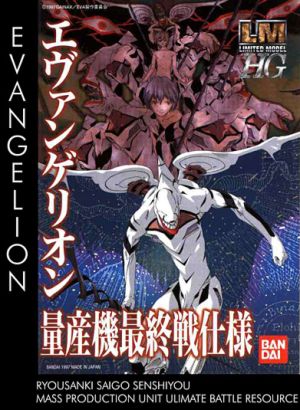
量産機 Literally meaning “Mass Production (Model) Unit”, this is a cool-sounding Japanese alternative (in the -gouki vein) to the usual terminology. Japanese materials commonly refer to the Mass Production Evas (see also harpy) by the rather vague “Eva Series”, which is sort of unpractical for two reasons: (A) “Eva Series” is misleading, since the term technically encompasses all Evas, not just the harpies, and (B) Japanese, being the way it is, uses “Eva Series” to refer both to the individual harpies and the group as a whole. (See e.g. the EoE script.) I ran into "Ryousanki" on the box covers of Bandai's EVA-05 model kits, although I'm sure it appears elsewhere.
S
Sammael

The true name of Satan — according to some, anyway, including Kabbalists, and, since we're talking about Evangelion, their concepts obviously take precedence. Sammael is represented in NGE by the twelve-winged angelic entity in the OP. Since Samm is the only angel to have twelve wings (because he's that cool), they're apparently telling us something by having GNR, and later EVA-01, sprout twelve wings in EoE. Strangely, Sammael himself makes absolutely no appearances in the actual anime, although he is secretly working behind the scenes, overseeing plot contrivances, setting up deus ex machinae, and keeping plot holes braced open so that the show retains enough structural integrity to make it to the bitter end. (At least, that's what he wants you to believe.)
BTW, anyone who calls him “Lucifer” will be neutered by Reichu with a rusty spoon.
Sauce
The colloquial NGE Geekdom term for "Hard Evidence" or citations. SAUCE is usually needed in some form for any theory to be widely accepted, and for any fact not directly stated in the show.
Seele Dudes
Aside from Keel Lorenz, none of the Seele Big Five (the Instrumentality Committee) have actual names, just countries of origin. Out of "boredom", fanon ones were fabricated: Nigel Laforey (U.K.), Theodore "Teddy" Cassin (U.S.), Pierre Bretagne (France), and Vladimir Kaganovich (Russia). It began in May 2005: The reason for "Teddy" should be somewhat obvious, and I thought "it would be funny to give [the rest] given names that are really stereotypical", hence Pierre and Vladimir. tv33 suggested Nigel for U.K.: "That just screams limey." More "boredom" in January 2006 resulted in Seele08 and myself looking up the names of WWII naval vessels for the relevant countries. Shortly thereafter, the appellation process was complete.
Shekinah
A fancier way of referencing GNR. In Judaism, Shekinah is essentially the Divine Presence, but, in Kabbalism, it has a special significance and is treated as the feminine manation of God, which “can only be reunited with God through human fulfillment of all the divine commandments” (source). Although GNR is never specifically identified as Shekinah (or, rather, NGE's take on Shekinah), there is ample reason to associate her with the concept. Supposedly.
Shipping

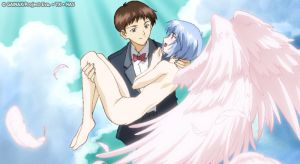
“Shipping”* is derived from “relationship” and refers to the universal geeky practice of (often quite passionately) advocating a romantic pairing between two fictional characters. Shipping is a popular pastime in NGE geekdom and most often revolves around who is best suited to Shinji:
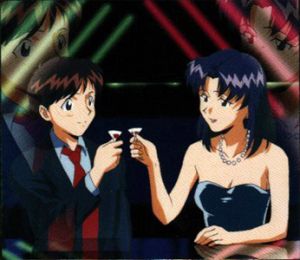
Asuka (the most popular choice), Rei (the runner-up), Kaworu (the choice for yaoi fangirls), Misato, or <insert other character of choice>. Other common choices are
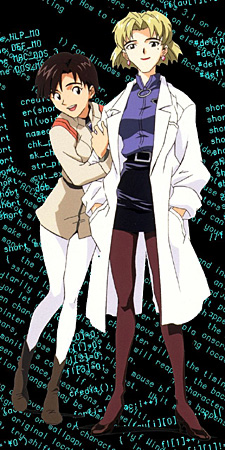
Misato/Kaji (which, like Gendo/Yui, is one of the very few canonical pairings), Hikari/Toji, Ritsuko/Maya, and Rei/Kaworu

— though pretty much any conceivable combination of characters is fair game, no matter how unbelievably farfetched, intentionally off-the-wall, or even downright wrong (with many-a-shady fan work exploiting the most disturbing possibilities). Non-canonical homosexual pairings are known as slash (referring to the “slash” that separates the names, i.e., Shinji/Kaworu). Shipping probably comprises the bulk of fanfiction, along with a heavy percentage of fan-art (oftentimes in the form of naughty pictures).
The opposite of shipping is known as anti-shipping, and refers to either (A) opposition to the phenomenon of shipping in general or (B) opposition to a particular pairing. Within our group, Mr. Tines is a particularly vehement opponent of Asuka/Shinji. (Although I should note, many of us don't "ship" Asuka/Shinji because we necessarily think they are well-suited to one another, but because we think it is the intention of the narrative.)
- “Shipping” is the noun, “to ship” is the verb, and a ”shipper” is someone who does it.
Shogouki
See -gouki.
Side Dish
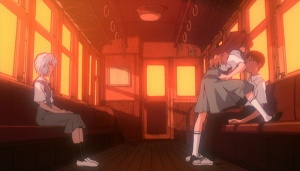
A Japanese metaphor used to describe something used in erotic fantasies. Asuka uses this metaphor in the "train" scene in The End of Evangelion. When the translations says: "Idiot! I know about your jerk-off fantasies of me." She actually says (in Japanese), "I know you've been using me as a side dish!" meaning that he has only been using her in his fantasies without trying to establish an actual relationship. Since this phrase would be meaningless to any non-Japanese viewer, it is proper translation to use the literal meaning of her words, instead of a literal word-for-word translation. However, an early EOE fansub, by an outfit called Psychlo, apparently translated from a Chinese bootleg which made the translation even more muddled, actually used "I know you only think of me as food!" for this line, leading to much head scratching and confusion.
Singularity
See Transition Guide.
Slash
See Shipping.
Stay-Puft Marshmallow Woman
Archaic. “Stay-Puft” part optional. An affectionate “nickname” for Lilith, who often seems to be made out of the popular white confection. This term is derived from the movie Ghostbusters, at the climax of which the city is attacked by the "Stay-Puft Marshmallow Man".
Entries penned (or simply assembled) by Reichu unless otherwise noted. Harsh statements about certain individuals are only expressions of geeky displeasure with their NGE-related flubs, not assaults on their actual persons. There's an important distinction.
